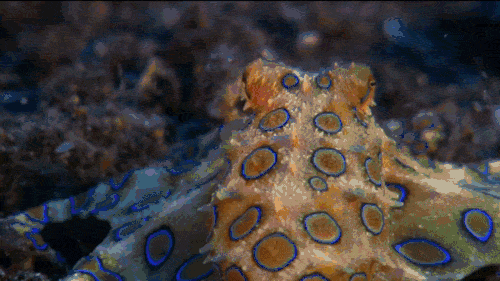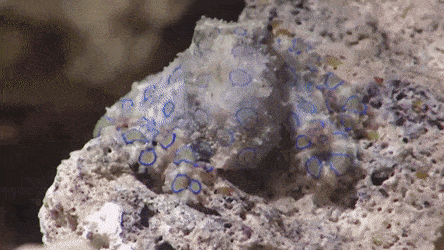
Blue ring octopus, known as the “most venomous marine creature”:
A review of the blue ringed octopus, know as the “most venomous marine creature”. The super-venomous cobra, which has no antidote so far
What do you think is the most poisonous creature in the world?
It is estimated that most people will answer: poisonous snake.
However, in the ocean, there is an octopus that is dozens of times more venomous than venomous snakes. There is still no antidote for its toxicity.

blue-ringed octopus
Many people feel very unfamiliar when they hear the name blue-ringed octopus.
In fact, this is because the blue-ringed octopus is not common in our country. Instead, it is an octopus that lives in the Pacific Ocean.
Under normal circumstances, the size of the blue ring octopus is not very large. It is basically the same size as the golf ball we see, and its wingspan is no more than 15 centimeters.
It can be said that when we see the appearance of the blue-ringed octopus, we actually think that it is very beautiful, at least it is one of the best among octopuses.

Like other octopuses, the entire body of the blue-ringed octopus is composed of soft tissue without any skeletal structure. It can be said that with this, the blue-ringed octopus can twist its body into any shape it wants. .
Even if it is a very narrow stone crevice, the blue-ringed octopus can squeeze in with its strength.
Smart predator
You know, the blue-ringed octopus is actually a very smart predator. It has color cells on its skin and can change its color at will.
In other words, when they move in different environments, they can “integrate” themselves with the color of the entire environment. This is actually somewhat similar to chameleons.
In normal times, they will use the pigment cells in their skin to hide themselves. Once they encounter prey, they will “open their mouths” directly.

And if other animals provoke it, the blue-ringed octopus will inflate like a balloon, and then directly change from blue to bright yellow, but it still has blue circular patterns on its body, which is where its name comes from. .
I have to say that the glowing blue rings on the blue-ringed octopus look really, really nice.
In this process, the blue-ringed octopus actually changes the size of cells of different colors on its body by shrinking or stretching, thereby changing its entire appearance.

Although the blue-ringed octopus is small in size, its defense methods are diverse.
In addition to its color-changing ability, the venom of the blue-ringed octopus is also frightening to people and animals.
“Unique” toxicity
Although the blue-ringed octopus is small in size, it is very powerful.
Inside the small body of the blue-ringed octopus, there is actually a very toxic “toxin” hidden in it. They are one of the most poisonous marine creatures, and even more so the most poisonous cephalopods.
After combining the opinions of scholars from all over the world, the American magazine “World Wildlife” selected the ten most poisonous species in the world through professional evaluation, and the blue-ringed octopus actually ranked third.

The most surprising thing is that even the “King Cobra” that everyone knows is ranked behind the blue-ringed octopus, and it is still far behind. This is enough to show the toxicity of the blue-ringed octopus.
There is an old saying that the brighter the color of the mushroom, the more toxic it is, and this is also true for the blue-ringed octopus.
Bright Color
In the entire ocean, the color of the blue-ringed octopus is already very bright, and this just proves to other animals that the blue-ringed octopus is poisonous and will run away after seeing it.
Generally speaking, blue-ringed octopuses eat small fish and shrimps. In the process of hunting, they will use their sharp beaks to pierce the prey’s body, or they will directly “inject poison”.
It can be said that once the blue-ringed octopus starts to release poison, there will be no “way to survive” for the prey nearby.
But generally speaking, blue-ringed octopuses do not release poison casually. They stay under the reef during the day and only come out to look for food at night.
And its character is not the kind to bite anyone it catches. As long as it does not feel that the nearby creatures are threatening it, the blue-ringed octopus will not take the initiative to attack or release toxins.
If you see a blue ring of light emitting from a blue-ringed octopus for more than a flash, be careful. This is actually a reminder that I will poison you if you don’t leave.
And once you are poisoned, there is no antidote.
There is currently no antidote
After expert research, it was discovered that the main toxin secreted by the blue-ringed octopus is “tetrodotoxin”, which is the “tetrodotoxin” that often appears in Japan.
This is actually a neurotoxin, and it can greatly hinder the conduction of nerves and muscles, and then gradually begin to stop breathing and heartbeat.
Not only that, but relevant studies have proven that the toxin of blue-ringed octopus is more than 1,000 times more powerful than potassium cyanide.
After being bitten by a blue-ringed octopus, you don’t actually feel much at first, but as time goes by, you will feel that your whole body becomes very weak. Basically, it will become very obvious after an hour. symptoms of poisoning.
This feeling is actually that when a person is fully conscious, he gradually feels that his whole body is paralyzed, then his breathing begins to gradually decrease, and finally his heart no longer beats at all.
Arguably, the most torturous aspect of this toxin is dying while awake.
Can easy kill
According to relevant data, the toxin released by such a small blue-ringed octopus can easily kill 26 adults.
However, the toxin of the blue-ringed octopus is not secret by itself, but by virus particles in its salivary glands.
To put it another way, these viruses actually reside in the salivary glands of the blue-ringed octopus.
When the blue-ringed octopus is threaten, the virus particles in its body are sens and release the toxin.
Previously, it was reveal on the Internet that some merchants were selling blue-ringed octopus and octopus together.
Even after the blue-ringed octopus is steam at high temperatures, the toxins in its body will not be decompose.
What’s even more unexpected is that because the blue-ringed octopus looks very good-looking. Its “ability” to change colors has attract the curiosity of many people, some people are trying to buy a blue-ringed octopus and keep it as a pet. feed.
What we need to know is that no one in the world has yet developed an antidote for blue-ringed octopus toxin. Once poisoned, it is basically hopeless.


One thought on “Blue ring octopus, known as the “most venomous marine creature”:”